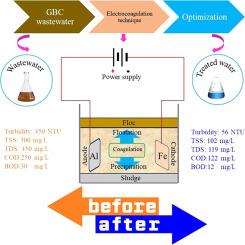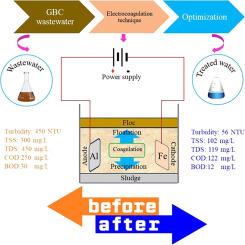Electrocoagulation treatment of wastewater collected from Haldia industrial region: Performance evaluation and comparison of process optimization
IF 12.4
1区 环境科学与生态学
Q1 ENGINEERING, ENVIRONMENTAL
引用次数: 0
Abstract
This study investigates the treatment of oil-contaminated wastewater with high levels of inorganic substances, suspended solids and turbidity, collected from the Haldia industrial region of India in February 2023. The wastewater, originating from industries such as chemical, petrochemical, textile, and battery manufacturing, presents a complex pollutant load that challenges traditional treatment methods. Electrocoagulation was employed as the treatment technique, with process optimization conducted using Box-Behnken design (BBD) and central composite design (CCD) for key parameters: pH, initial oil concentration, current density, and electrolysis time. The study comprehensively examined the effects of these parameters on turbidity removal. The optimal conditions were determined to be a pH of 7.5, an initial oil concentration of 275 mg/L, a current density of 17.5 mA/cm², and an electrolysis time of 20 min. Under these conditions, CCD outperformed BBD, achieving a desirability score of 93 % compared to 80 % for BBD. The process successfully reduced turbidity from 450 NTU to 56 NTU and total suspended solids (TSS) from 300 mg/L to 102 mg/L. The operation cost of the process was found to range from ₹0.904/m³ to ₹2.71/m³ as the electrolysis time increased from 0.17 to 0.5 h. The study presents a viable solution for industrial wastewater treatment in this region, aligning with the United Nations Sustainable Development Goal (UN SDG) 2030. Additionally, combining electrocoagulation with membrane filtration may enhance comprehensive pollutant removal.


电凝法处理 Haldia 工业区收集的废水:性能评估与工艺优化比较
本研究调查了 2023 年 2 月从印度 Haldia 工业区收集的含油废水的处理情况,这些废水含有大量无机物、悬浮固体和浊度。这些废水来自化工、石化、纺织和电池制造等行业,污染负荷复杂,对传统的处理方法提出了挑战。该研究采用电凝作为处理技术,并针对 pH 值、初始油浓度、电流密度和电解时间等关键参数,采用方框-贝肯设计(BBD)和中央复合设计(CCD)对工艺进行了优化。研究全面考察了这些参数对去除浊度的影响。最佳条件被确定为 pH 值为 7.5、初始油类浓度为 275 mg/L、电流密度为 17.5 mA/cm²、电解时间为 20 分钟。在这些条件下,CCD 的表现优于 BBD,可取性得分达到 93%,而 BBD 为 80%。该工艺成功地将浊度从 450 NTU 降至 56 NTU,将总悬浮固体 (TSS) 从 300 mg/L 降至 102 mg/L。研究发现,随着电解时间从 0.17 小时增加到 0.5 小时,该工艺的运行成本从 ₹0.904/m³ 增加到 ₹2.71/m³ 。此外,将电凝技术与膜过滤技术相结合可提高污染物的综合去除率。
本文章由计算机程序翻译,如有差异,请以英文原文为准。
求助全文
约1分钟内获得全文
求助全文
来源期刊

Water Research
环境科学-工程:环境
CiteScore
20.80
自引率
9.40%
发文量
1307
审稿时长
38 days
期刊介绍:
Water Research, along with its open access companion journal Water Research X, serves as a platform for publishing original research papers covering various aspects of the science and technology related to the anthropogenic water cycle, water quality, and its management worldwide. The audience targeted by the journal comprises biologists, chemical engineers, chemists, civil engineers, environmental engineers, limnologists, and microbiologists. The scope of the journal include:
•Treatment processes for water and wastewaters (municipal, agricultural, industrial, and on-site treatment), including resource recovery and residuals management;
•Urban hydrology including sewer systems, stormwater management, and green infrastructure;
•Drinking water treatment and distribution;
•Potable and non-potable water reuse;
•Sanitation, public health, and risk assessment;
•Anaerobic digestion, solid and hazardous waste management, including source characterization and the effects and control of leachates and gaseous emissions;
•Contaminants (chemical, microbial, anthropogenic particles such as nanoparticles or microplastics) and related water quality sensing, monitoring, fate, and assessment;
•Anthropogenic impacts on inland, tidal, coastal and urban waters, focusing on surface and ground waters, and point and non-point sources of pollution;
•Environmental restoration, linked to surface water, groundwater and groundwater remediation;
•Analysis of the interfaces between sediments and water, and between water and atmosphere, focusing specifically on anthropogenic impacts;
•Mathematical modelling, systems analysis, machine learning, and beneficial use of big data related to the anthropogenic water cycle;
•Socio-economic, policy, and regulations studies.
 求助内容:
求助内容: 应助结果提醒方式:
应助结果提醒方式:


